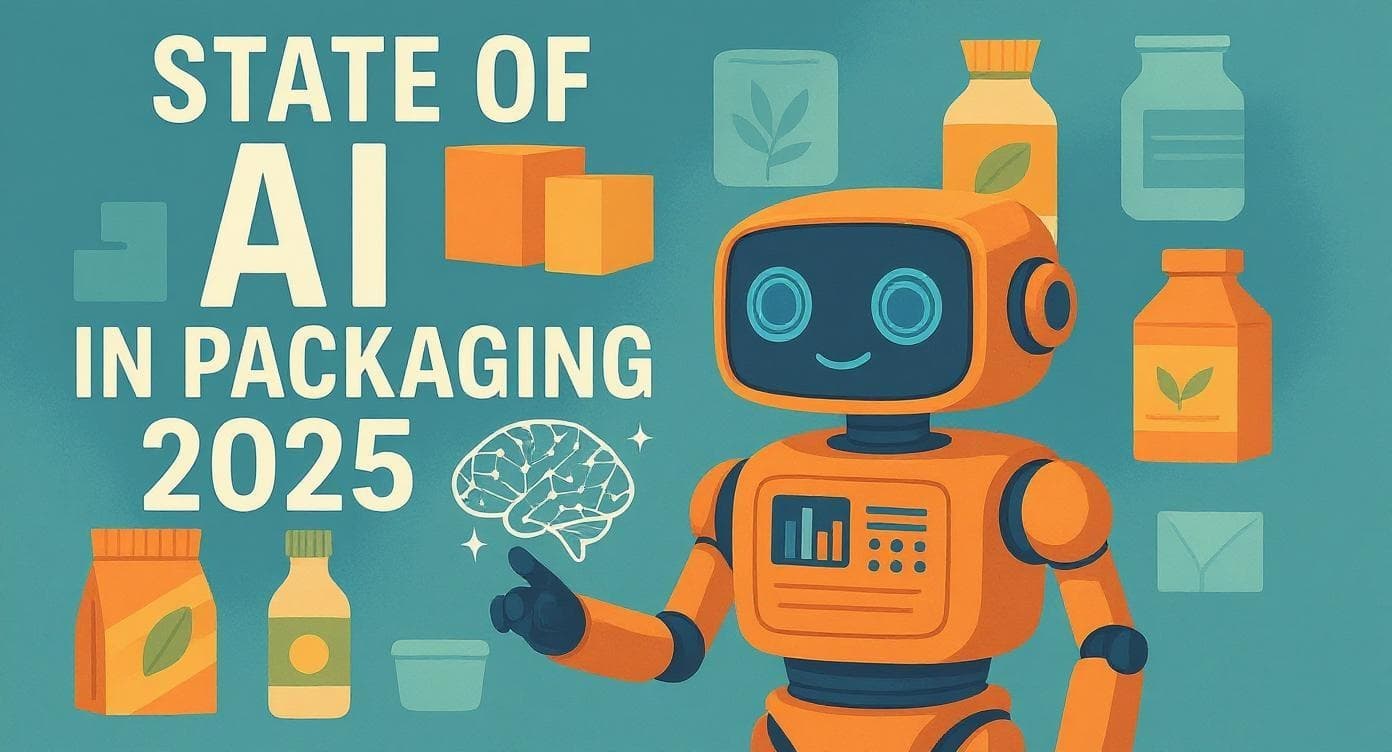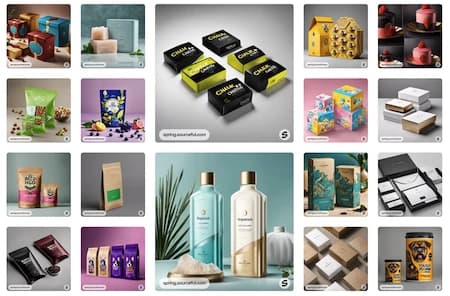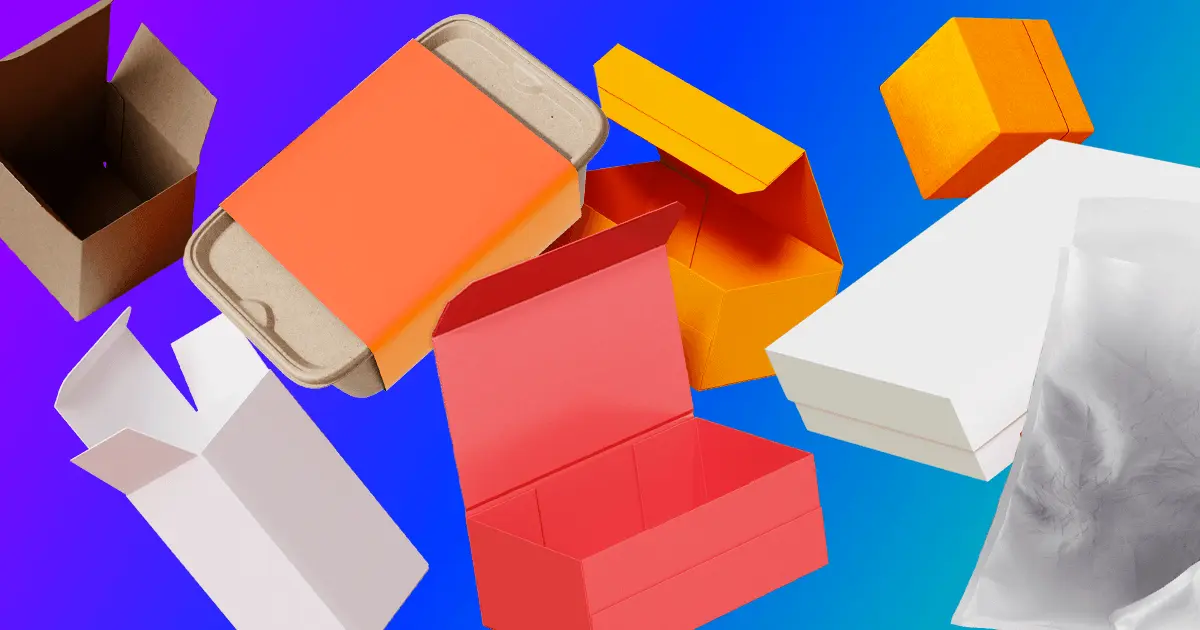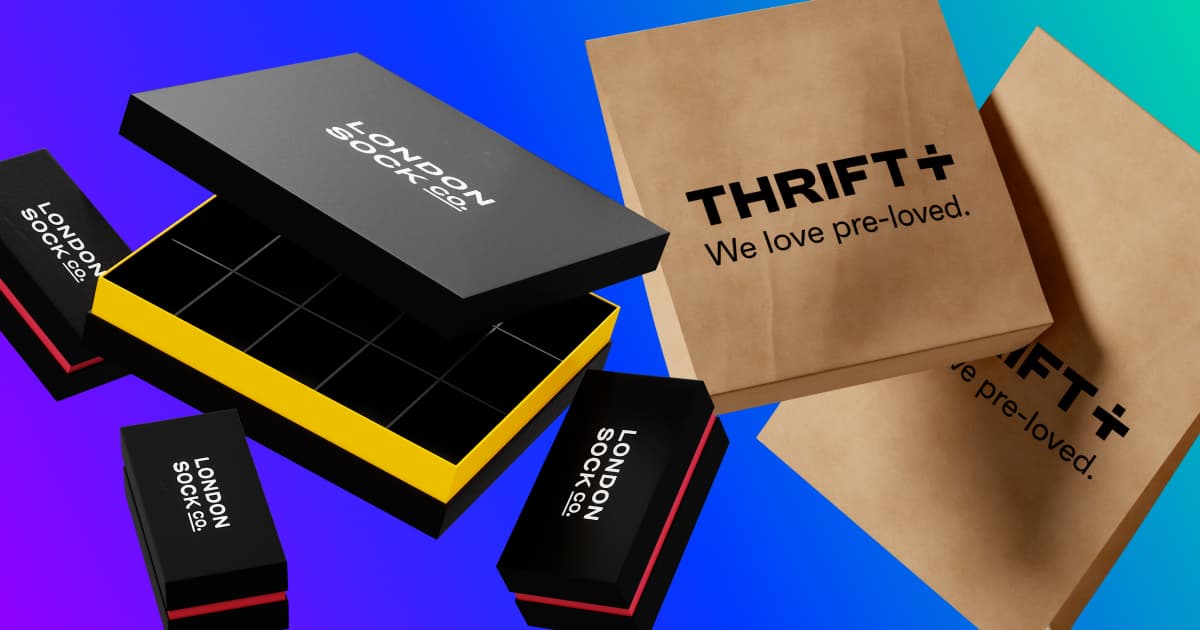Blog Post23 sustainable packaging design ideas
- Sustainability
- Design
Rachel LawtonFebruary 28, 2023 - 8 min read
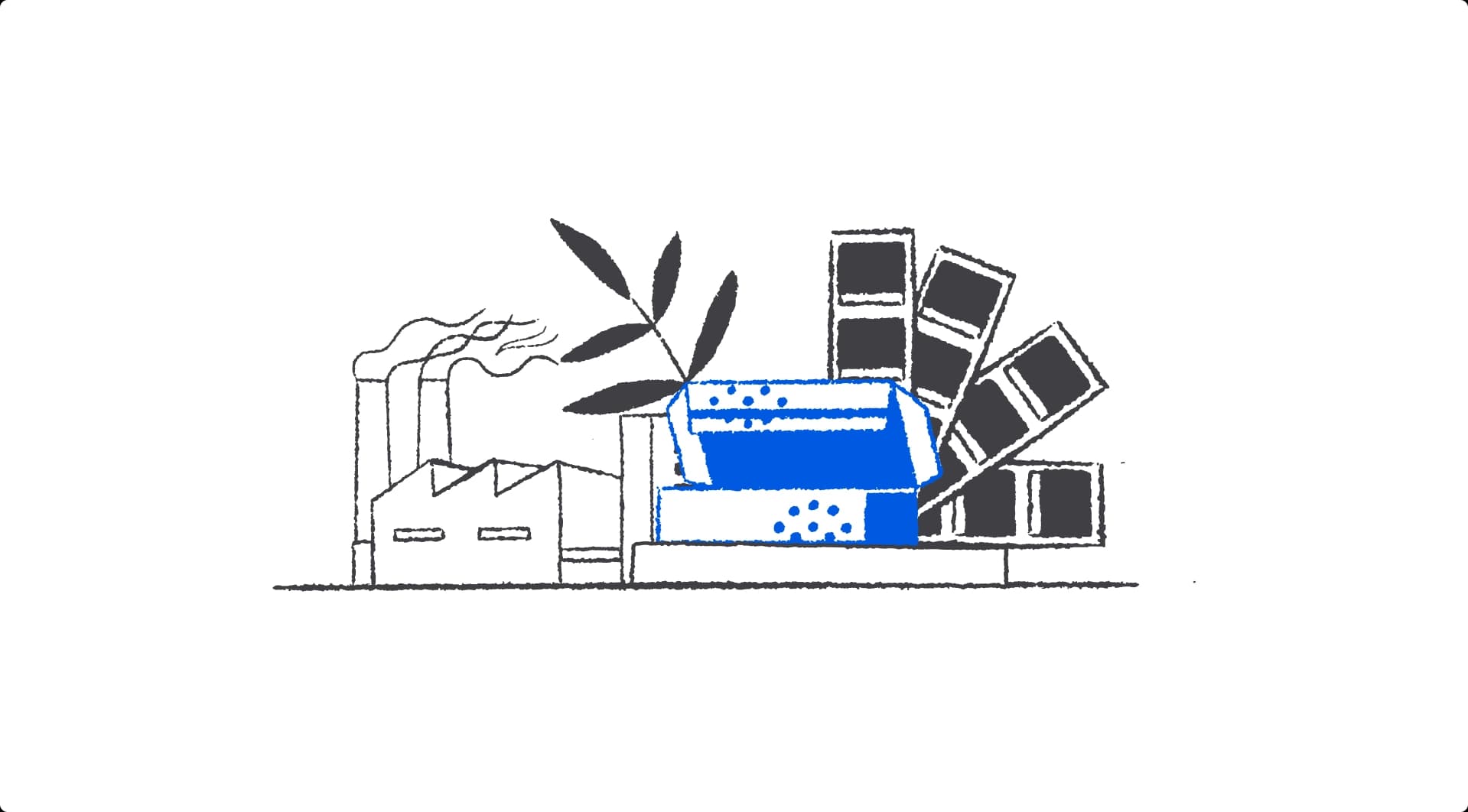
From sugarcane to paper that acts like honeycomb, more sustainable packaging materials are becoming increasingly available for businesses that want to reduce their environmental impact. But with so many possible designs, making the right choice can be a challenge.
We’ve put together a list of 26 ideas to help you understand the materials available, so that you make the right choice for your business, putting you firmly on the path toward more sustainable packaging.
What is sustainable packaging design?
Sustainable packaging design is designing packaging to have the smallest environmental impact possible. This can involve using natural, chemical-free materials, more efficient sizing or designing with your product’s end of life in mind. In reconsidering packaging design, you have an opportunity to reduce your carbon footprint, stay ahead of extended producer regulations and increase brand loyalty.
Why sustainable packaging design is necessary
In 2020, packaging waste in Europe reached 79.3 million tonnes. Whilst recycling rates have been mostly increasing in the last decade, they remain low compared to total waste, especially for plastic. As a result, a lot of single-use packaging is discarded and ends up in landfills and waterways. Here, it takes longer to break down, can release toxic chemicals, poses a risk to wildlife and ultimately contributes to greenhouse gas emissions.
Customers are increasingly looking to businesses to take the lead on sustainability. There’s an opportunity for businesses not only to ensure their packaging can be recyclable but to also examine their packaging’s total life cycle and reduce its environmental impact long before it reaches the customer.
Design examples for 6 sustainable packaging materials
The sustainable packaging industry is rapidly expanding. You can now choose from tried and tested natural materials, such as corrugated cardboard, to innovative market disruptors, like mycelium.
Deciding which one is right for you depends on the functional needs of your product (barrier properties, level of protection, etc.), your sustainability targets and your budget.
1. Corrugated cardboard
Corrugated cardboard is one of the most sustainable packaging materials available. It consists of a corrugated sheet, commonly known as fluting, sandwiched between two kraft paper liners. Each of these components can be FSC-certified, whilst the fluting usually contains a high degree of recycled material. Corrugated cardboard is also widely kerbside recyclable, which makes it easier for customers to dispose of it more sustainably.
Fluting comes in a variety of thicknesses and is what gives the cardboard its strength. A thicker, double-walled flute offers the greatest protection, whilst a thinner, single-walled flute is still durable but uses fewer materials. This is a hidden opportunity in sustainable packaging design because getting the level of protection just right reduces the risk of damage and returns, which can add to your carbon footprint if left unchecked.
Corrugated cardboard does have a few drawbacks. For example, it’s not completely waterproof. What’s more, if not stored correctly it can lose its strength, as moisture and temperature fluctuations can cause its structure to warp and weaken. But its continued popularity shows that its benefits as a strong, recyclable packaging material far outweigh any downsides.
Here are some products that use corrugated cardboard:
Mailer boxes
If you’re looking to create a memorable unboxing experience, mailer boxes are a great option. They're fully customisable, which means you can print as much or as little as you want to showcase your brand’s personality. Custom sizing then allows you to make sure your packaging is the right size for your product, which can further reduce its carbon footprint by up to 8%.

Shipping boxes
For heavier or bulkier items, shipping boxes are ideal. Their strength is largely determined by the fluting, which can be chosen according to the protection needed. Like mailer boxes, shipping boxes can be customised to ensure they're the right size for your product, which reduces unnecessary space and allow you to ship more efficiently.
Crash lock boxes
Crash lock boxes are an alternative to mailer boxes. While they boast the same performance qualities, they’re faster to assemble by hand, saving time and labour costs. What’s more, a lot of their strength comes from their interlocking sides, which means fewer adhesives and fewer materials.
Box dividers
Box dividers are normally paired with shipping boxes to protect products from moving around in transit. A range of styles and shapes means they can be used to keep products of all kinds safe. Using box dividers as a protective measure can also reduce the need for void fillers, such as packing peanuts, which avoids unnecessary waste.
Custom inserts
Custom inserts are die-cut to the shape of your product, holding it in place during transit before showcasing it when your customer opens their package. When paired with a mailer box, inserts can help you create a memorable unboxing experience and both insert and box can be recycled after use.
Book mailer
Book mailers are a cost-effective packaging solution for shipping books, magazines, and other flat products. And because they can be folded at any height, you only need to order one size which reduces the number of SKUs you have to manage. This versatility also reduces redundant space in your packaging allowing you to ship your product more sustainably.
Not only can book mailers be FSC-certified, but they can also be made from 100% recycled material. Once they have served their purpose, they can be put back into the resource stream to be recycled into new paper and card products, reducing the demand for virgin materials.
2. Kraft paper
From the corrugated cardboard packaging above to our envelopes and gummed tape, we at Sourceful rely on kraft paper products to help brands switch to more sustainable packaging.
Kraft paper is made from wood pulp and can be responsibly sourced under FSC standards. Kraft paper products can also be widely recycled at the roadside. This reduces waste ending up in landfill and means fewer virgin materials are needed to create new products.
Kraft paper does have a few limitations to bear in mind. For example, like corrugated cardboard, it’s not waterproof. What’s more, intricate designs won’t stand out as much on unbleached paper as they would on its bleached counterpart.
Nevertheless, in both its bleached and unbleached forms, kraft paper can be printed on to build brand awareness. It’s even considered a symbol of sustainability and celebrated amongst customers and businesses for its natural appearance.
At Sourceful we use kraft paper in our boxes and some of our more lightweight packaging, including mailer bags and gummed tape.
Paper mailer bag
For soft, non-fragile items such as clothes, paper mailer bags can be a more sustainable option than traditional plastic poly mailer bags. They’re thin and lightweight, which means fewer emissions during transit. And because of their flexibility, there are fewer voids to fill, making your packaging even more sustainable.
Paper mailer bags are splashproof and recyclable.
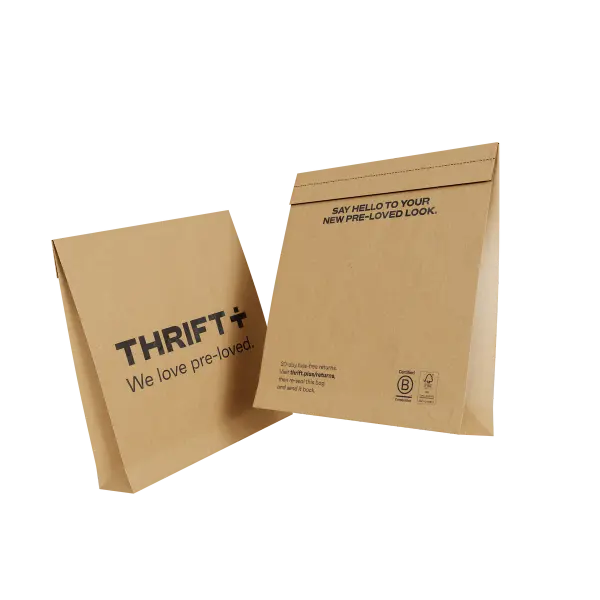
Honeycomb mailer bag
Taking its cue from nature, the honeycomb mailer bag has the same benefits as the paper mailer bag but uses built-in kraft paper padding to offer additional protection. Although this uses more materials, it reduces the risk of damage for fragile projects that paper mailer bags aren’t suited for, which in turn reduces returns and extra transport emissions.
Gummed tape
Gummed tape is a more sustainable alternative to plastic-based tapes, which are petroleum-derived and can be difficult to recycle. Instead, gummed tape is made from renewable, natural resources: kraft paper and a starch-based adhesive. It’s kerbside recyclable and using it in place of traditional packaging tape can reduce your carbon footprint by up to 50%.
Gummed tape can also be printed on, adding a little personality to your packaging and building awareness for your brand.
3. Cartonboard
From gift cards to paracetamol boxes, cartonboard is a familiar sight in shops and supermarkets. It offers protection without the need for plastic and can be customised in size, shape and colour to be both protective and attractive.
Cartonboard’s thin, lightweight qualities reduce its carbon footprint during shipping compared to thicker or heavier packaging materials. What’s more, FSC-certified cartonboard comes from responsibly managed forests and is a more sustainable alternative to plastic packaging.
With no fluting, cartonboard is not as strong as corrugated cardboard, so it’s best used for smaller or lighter items that aren’t at risk of being damaged.
Cards
FSC-certified cards can help you communicate your sustainability efforts to customers. You can choose between flat or folded styles, and they come in a variety of sizes. To make sure you’re not adding unnecessary materials to your packaging, we recommend using cards only if they serve a real purpose.
Sourceful cards are widely kerbside recyclable so customers can dispose of them with ease.
4. Recycled plastic
Plastic is popular thanks to its durability and protective qualities. Yet, 79% of all plastics ever made are still in landfill or out in the environment. Plastic can take at least 400 years to degrade and can release harmful chemicals as it breaks down.
So, when you need the properties of plastic, using plastics already in circulation and giving them a second life can reduce the damage that they can do to the environment. By including at least 30% of recycled plastic in your packaging, you’re also exempt from the Plastic Packaging Tax.
Recycled mailer bags
Here at Sourceful, we're leading the charge against plastic pollution with our 98% recycled content mailer bag. It’s GRS-certified (Global Recycled Standard), which verifies the recycled materials content and ensures complete supply chain transparency.
Recycled mailer bags offer a more sustainable alternative to traditional poly mailer bags which are made with virgin plastics. Using our 98% recycled plastic mailer bag can reduce your carbon footprint by up to 30%, whilst using our 30% recycled plastic mailer bag can reduce your carbon footprint by 9% compared to virgin poly mailer bags.
And just because they're recycled doesn’t mean you have to compromise on appearance. Both recycled mailer bags can be printed on to reflect your brand and increase customer awareness. Whilst our 98% recycled mailer bag does have some white flecks due to the high quantity of recycled material, you could use this as a badge of honour to showcase your commitment to sustainability.
Deciding which is right for you will depend on how you balance your business’s branding with your sustainability efforts. The good news is that using either bag means your business will be exempt from the plastic packaging tax, whilst reducing the amount of plastic in circulation.

5. Sugarcane pulp
Packaging innovators have been searching for more sustainable materials in response to the plastic packaging waste crisis. And one promising material is sugarcane pulp. What's great about sugarcane pulp products is that they're made from sugarcane fibres, which are a byproduct of the sugar industry and would otherwise be incinerated or thrown away. By using this waste input, less material goes to landfill and fewer virgin materials are needed.
Sugarcane pulp products can be collected for recycling and reprocessed into other products. These products shouldn't, however, be confused with sugarcane “bioplastics” which often have additional, non-renewable chemicals added and can only be composted industrially.
Sugarcane pulp inserts
Sourceful’s sugarcane pulp inserts can be combined with a mailer box to create an impressive unboxing experience. These paper-like inserts can be moulded to fit any shape, which keeps your products in place and on display as you intended.
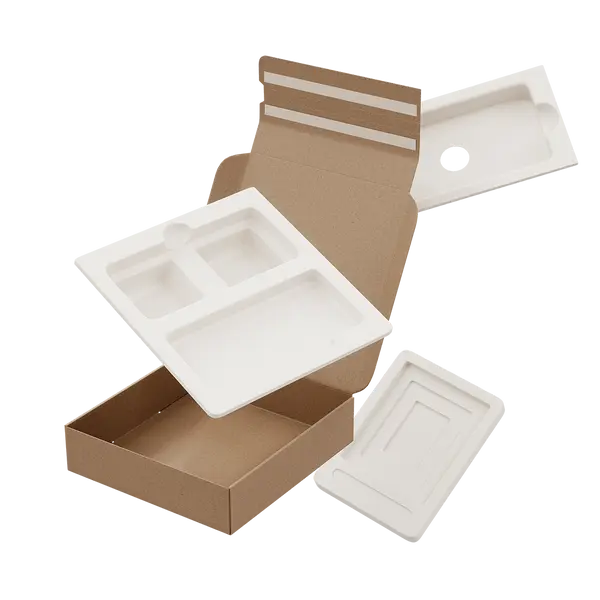
3 easy steps to move towards sustainable packaging design
Choosing a more sustainable material can go a long way in making your packaging more eco-friendly. But there are other design choices you can make that don’t require changing materials that can still help you to reduce your packaging’s waste and carbon footprint.
1. Reduce your packaging size
Did you know that the average box is 40% too big for its contents? This means that even if you’ve chosen the most sustainable material possible, the extra space your packaging takes up means you can ship less in one go, which increases your carbon footprint.
By making your packaging the right size for your product, you can combat this waste. This will also save you money as you’ll reduce the shipping cost per item.
What’s more, tighter-fitting packaging means that products aren’t at risk of rattling around in transit, so you can also reduce your need for void fill.
2. Reduce unnecessary materials
Reducing your void fillers and packaging size aren’t the only ways you can save on materials. You can also think about any extras your packaging has, such as cards or leaflets.
If you do want to communicate with your customers, a great way to do this without adding extra materials is to print QR codes on your packaging. Your customers can scan these with their smart devices and access the same information through a website instead of on paper.
3. Simplify your packaging’s appearance
Using colours and designs in your packaging can show off your brand personality and make for an impressive unboxing experience. And, if you’re using packaging printed on with water-based or vegetable-based inks, you’re already using a more sustainable alternative to the traditional solvent-based inks.
But, if you want to go the extra mile, you could reduce the designs on your packaging’s exterior and embrace its more natural appearance.
Our Studio lets you play with endless design ideas until you find one that’s perfect for you. Even if you don’t have any experience designing packaging, you can visualise your new packaging easily and within minutes. When you’re done, our experts will proof every inch ahead of production so you can design with confidence.
Design sustainable packaging with Sourceful
The growth of the e-commerce industry means that packaging waste is set to rise. But you can reduce your environmental impact by examining your current packaging and thinking about what can be changed to make it more sustainable.
And admittedly with so many materials and styles to choose from, it can be difficult to know where to start. But we’re here to help with that.
Chat with our team of experts about how you can start making the switch to more sustainable packaging today.




